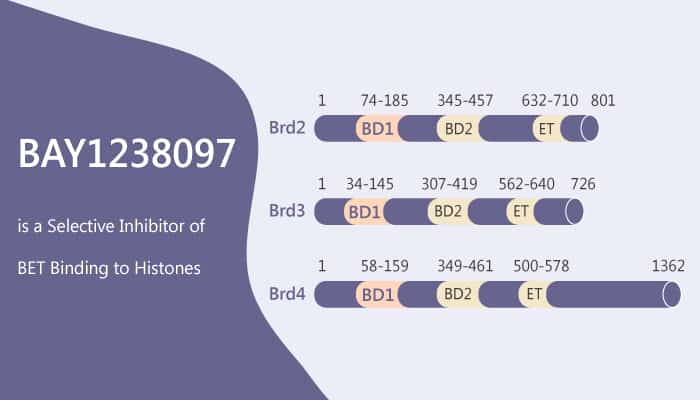Several BET inhibitors with strong anti-tumor efficacy have been described in recent years. Most of them are derived from diazepine and azepine scaffolds, besides, more recently quinazolinones and isoxazoles chemotypes have been identified.
Additionally, a study from Pascale Lejeune identified and verified a novel BET inhibitor BAY1238097, which shows excellent anti-tumor activity.

In vitro, BAY1238097 shows strong inhibitory activity (IC50 < 100 nM) in a TR-FRET assay using BET BRD4 bromodomain 1 and an acetylated peptide derived from histone H4. In the NanoBRET assay, the interaction between BRD4 (IC50=63 nM), BRD3 or BRD2 (IC50=609 nM) and H4 (IC50=2430 nM) is inhibited.
In addition, BAY1238097 has in vitro anti-tumour activity in lymphoma models. Firstly, BAY 1238097 affects the gene expression of GCB DLBCL cells. At the gene level, BTK, CCDC86, CCND2, CD19, CD27, FAIM, FCMR (FAIM3), IL7R, IRAK1, MAPK13, MYB, MYC, PDE4B, TNFRSF13B, TNFRSF17 are among the top downregulated genes. Beside histone-coding genes, the upregulated genes include CCL5, CDKN2C, CD69, JUN, and MKNK2.
Furthermore, in vivo, BAY 1238097 shows strong efficacy in the AML models THP-1, MOLM-13 and KG-1, with T/C between 13 and 20%. BAY 1238097 is also active in MM models in a human IGH-cyclin D1 translocated MOLP-8 model with a T/C of 3%. In this model, BAY 1238097 is well tolerated at 10 mg/kg applied over 14 days, with no body weight loss measured. BAY 1238097 is also active against the FGFR/MMSET translocated model NCIH929, with 19% T/C versus 49% T/C for the standard-of-care CC-5013. Besides, it is well tolerated applied at 12 mg/kg for 9 days (maximum body weight loss 6%). BAY 1238097 has in vivo anti-tumour activity in lymphoma models.
Reference:
Lejeune, P, et al., (2015) Abstract 3524: BAY 1238097, a novel BET inhibitor with strong efficacy in hematological tumor models. Cancer Research, 75(15 Suppl), 884.
Bernasconi E, et al., Preclinical evaluation of the BET bromodomain inhibitor BAY 1238097 for the treatment of lymphoma. Br J Haematol. 2017 Sep;178(6):936-948.